- Home
- Deborah Harkness
The World of All Souls Page 9
The World of All Souls Read online
Page 9
In the beginning of the All Souls world, the witches known as weavers were able to devise new spells as opposed to repeating or adapting old ones. They did so using weavers’ knots and by binding and unbinding the powers of nature. Gradually other witches grew to fear the power of the weavers in their midst and the attention they engendered in humans. In the twelfth century, around the time that the Catholic Church began to seek out a variety of heretics, witches attempted to exterminate all known weavers and their offspring. They did this for their own safety and to preserve the old ways, but it had the undesirable result of stultifying magical culture.
Human, vampire, and daemonic persecution of witches has a long history. In the Judeo-Christian tradition, passages in the Old Testament have been used to justify the killing of witches. In the early 400s, St. Augustine argued that because only God could suspend the laws of nature, witchcraft was simply a delusion, deserving punishment but not death. Yet as suppression of all heretics (including Jews, magicians, and homosexuals) developed in the twelfth and thirteenth centuries, the attitude toward witches grew less tolerant. In 1484 Pope Innocent VIII declared that witches in Germany were consorting with devils and casting spells that destroyed crops and aborted infants. He asked for a full report on this activity. The result was the famous Malleus Maleficarum, or Hammer of Witches, the most influential witch-hunting manual ever produced. After its publication it was a heresy for a good Christian not to believe in witches.
The Malleus Maleficarum bolstered the beliefs held by generations of theologians and judges that witchcraft subverted the rule of heavenly and earthly order. As far as the common people were concerned, the witch neighbors who cured their rashes and helped deliver their children were just as capable of causing crop failures and other tragedies. There are almost as many theories about the causes of witchcraft trials as there are historians, but there is no question that witches made convenient scapegoats for human problems during the period of the witch-hunts.
The changing whims of rulers and others in political power could also affect the status of witches. King James VI of Scotland had initially been tolerant of witches but changed his mind after experiencing terrible storms on the way back from Copenhagen with his new Danish queen in 1589. The Danes who were escorting the couple home blamed witchcraft, and trials were held in Denmark to punish the malefactors. James then set up his own tribunal in Scotland, which came to be known as the North Berwick Witch Trials.
In the Berwick trials, officials arrested a young Scottish servant on suspicion of witchcraft in 1590. Under torture she named many others, including John Fian, a local schoolmaster; Agnes Sampson, a cunning woman (actually a weaver), healer, and midwife; and Barbara Napier, the widow of Earl Archibald of Angus. Agnes Sampson and John Fian were tortured and eventually executed, though Fian bravely recanted his initial confession and his legs were crushed by a pair of iron boots. Barbara Napier escaped her fate for a time by claiming to be pregnant (with the support of Gallowglass’s companion Davy Hancock) but was eventually executed as well.
Witch trials took place in various European countries and in the American colonies from the fourteenth through the eighteenth centuries. It is difficult to know how many witches were executed. Modern scholars put the number at roughly forty to fifty thousand. In Great Britain the trials came to an end when the Witchcraft Act of 1735 made it a crime for a person to claim that any human being had magical powers or was guilty of practicing witchcraft. It is interesting to note that even then, the humans who crafted the laws were careful to acknowledge the traditional distinction between elemental magic and the craft, and to include both types of power in their rules.
In the American colonies, witch-hunts occurred mainly in Massachusetts and Connecticut. The most famous trials occurred around Salem, Massachusetts, in 1692–93. The towns involved included Salem Village (now Danvers), Salem Town, Ipswich, and Andover. Nineteen of the convicted witches were executed by hanging, the first being Diana’s ancestor Bridget Bishop. One of the most damaging pieces of evidence against Bridget was that she possessed poppets, which were dolls used in spell casting. One of these poppets survived the centuries to play an important role in Diana and Matthew’s quest to find the Book of Life. An accused wizard was the twentieth victim. He was pressed to death under a board for refusing to dignify the court with any plea at all. Contrary to popular belief, no witches were ever burned in America.
The days of persecution for witchcraft are not past,* especially in the developing world. In Western cultures humans often refuse to believe in the existence of witches (or vampires, or daemons), but they are not much more tolerant of difference than were their medieval ancestors.
See also:
CHARACTERS: Goody Alsop, the members of the Bishop family, Gillian Chamberlain, Vivian Harrison, Peter Knox, Satu Järvinen, Emily Mather, Stephen Proctor, Catherine Streeter
MAGIC
LIFESTYLES: All Souls Recipes, Herbs and Medicinals
LITERATURE: The Discovery of Witches, Malleus Maleficarum, “Body’s Beauty” (Lady Lilith)
Many readers ask me which creature I’d want to be if I could choose. You know, I think I’m happy being human. Witches bear too much responsibility, vampire lives are long and challenging, and daemons are chronically misunderstood. I would like a vampire’s private jet, though.
If you could be a witch, daemon, or vampire, which would you choose?
To find out, take the creature quiz here: deborahharkness.com
Characters
A
ALAIN & VICTOIRE
Full names: Alain Le Merle, Victoire Le Merle
Origin of name: Of French origin, from the word “merle” (and Latin, merula) meaning “blackbird”
Date of birth: Unknown
Date of rebirth: Unknown
Physical description: Alain has salt-and-pepper hair, lines around his kind eyes, and a wiry build. He has a slight hitch in his gait.
Family and romantic relationships: Alain and Victoire were made into vampires by Marthe, another of the de Clermonts’ most trusted servants, and have been lifelong mates.
Personal history: Alain began as Philippe de Clermont’s squire, and Marthe turned him into a vampire soon after. He knows every aspect of the Knights of Lazarus business, and when Philippe died, he transferred his allegiance to Matthew. A servant in the de Clermont household for centuries, Alain is unwaveringly loyal to the family. Matthew knows he can always trust and turn to him. As well as French, Alain speaks flawless English. Victoire is as loyal a servant as her husband, seeing to the needs of the de Clermonts, from making new clothes for Diana to looking after the twins, Rebecca and Philip.
GOODY ALSOP
Full name: Goodwife Alsop
Origin of name: Goody is a shortened form of Goodwife, a polite form of address for women who are not of high enough social standing to be called Mistress. Alsop is an old surname of Anglo-Saxon origin.
Date of birth: January 30, 1510
Astrological sign: Aquarius
Physical description: Old and thin, with fine features and stooped shoulders
A member of: The St. James Garlickhythe gathering/coven
Family and romantic relationships: Her husband, Thomas Skelton, was a blacksmith and a well-respected witch.
Personal history: Goody Alsop was a weaver, one of the last remaining in the British Isles at that time, a windwitch and leader of the St. James Garlickhythe gathering in sixteenth-century London. She taught Diana what it meant to be a weaver and how to unlock her powers, and she was herself an apprentice to the famous witch and powerful seer Ursula Shipton. Perhaps one of the most important lessons Goody taught Diana is that “every weaving is as unique as the weaver who makes it. The goddess does not want us to imitate some ideal of perfection, but to be our true selves.”
GERBERT D’AURILLAC
Full name and other names: Ge
rbert of Aurillac, Pope Sylvester II
Origin of name: Aurillac is the town in the Auvergne, France, where Gerbert is from.
Date of birth: c. A.D. 700 (alternatively recorded as c. A.D. 946)
Date of rebirth: c. A.D. 740
Physical description: Gerbert appears to be over fifty. He is of average height by modern standards, at about five-ten. With a slightly receding hairline, high cheekbones, deep-set eyes, and a prominent nose, he is rather cadaverous in appearance. An impression of Gerbert as Pope Sylvester II can be seen inside the Basilica of Saint Paul Outside the Walls in Rome.
A member of: The Congregation
Family and romantic relationships: The historical records for Gerbert’s human parentage point to humble origins in the south of France.
In the Middle Ages there were rumors he was involved with the succubus Meridiana. Gerbert is now head of his own vampire clan based in the Cantal. His host of dangerous vampire children included the unstable Juliette Durand. He has no mate and uses relationships only for his own ends.
Personal history: Gerbert is a schemer as well as a vampire, which enables his plots to unfold over a very long span of time. This ensures that his maneuvering is almost impossible to track unless you are older and wiser than he is—and few creatures can make that claim.
Like Matthew, Gerbert is a native of the Auvergne, although he was born a few centuries after Matthew. He struggled through his childhood in a large and competitive vampire pack. When his maker was killed in the last of France’s Vampire Wars, falling in battle to his great rival Philippe de Clermont, it was Gerbert who eventually assumed clan leadership. This was achieved through murder, skulduggery, and underhanded tactics rather than via a legitimate claim—a hallmark of Gerbert’s leadership style. It also made Gerbert a devoted enemy of the de Clermonts, though at times he and Ysabeau de Clermont have managed to work amicably together against their shared enemy, the witches.
Gerbert decided in the tenth century that the Catholic Church provided a way to advance his own agenda—namely, domesticating the human population into a permanent class of livestock to serve vampire interests. As the church’s power grew and humans followed it in great numbers, Gerbert decided to align himself with it. He entered a monastery and went on to study in Spain, immersing himself in rich intellectual centers of Islamic learning such as Córdoba and Seville. This gave Gerbert access to works unknown or lost to Europe from the classical period (as was the case for Matthew de Clermont, who also studied in Córdoba around this time). He particularly focused on mathematics and astronomy. Later traveling to Rome, Gerbert rose to prominence within the church hierarchy. Eventually he was elected pope and was known as Sylvester II.
As the first French pope and a man of great scholarship, Pope Sylvester II was famed for reintroducing the abacus and the armillary sphere to Europe, as well as complicated Arabic arithmetic. His scholarship also drew great suspicion from his contemporaries, and dark legends grew around him. The English monk William of Malmesbury described in his eleventh-century chronicles how Gerbert had made a pact with the devil and while studying in Spain had stolen a precious book from an Arab philosopher there. Coveting the book’s secrets, Gerbert had seduced the man’s daughter to aid him in his theft. Gerbert was also said to have been in league with a demon, Meridiana, who helped him in his ascendency to the highest position in the church, and that he built a brazen head, which could divine the future. As All Souls readers know, it was in fact the Book of Life that Gerbert stole from a great wizard in Toledo, and Meridiana was a weaver whom he held in thrall, attempting, unsuccessfully, to use her power to unlock the manuscript’s secrets.
Gerbert’s activities as Pope Sylvester II, and the ensuing complications of staging his “death” in 1003, led directly to the Congregation’s ban on creatures taking any further public role in human politics and religion.
Gerbert’s greatest desire is the triumph of vampire culture over daemons, humans, and witches. A staunch conservative and a believer in the innate superiority of the vampire race, Gerbert dislikes the covenant. He hopes to dispense with it and the Congregation once he achieves his aims of vampire domination. He’s been working on this plan steadily behind the scenes since around 1100 and has amassed an enormous clan of disenchanted, angry vampires. They are based in the Cantal but have migrated far and wide and can be found in banks, universities, churches, synagogues, mosques, and political institutions all around the world. Gerbert’s only obstacle is the witches. Thus he has made a study of magic and the occult and has been known to try to transform witches and even daemons into vampires to see if something magical might come of it. Most of his experiments have been a disaster. He knew about weavers before Diana’s revelation to the Congregation and was the one who fed Benjamin Fox information to work against the de Clermonts. The full extent of Gerbert’s malign plotting through the centuries has now become clear to the de Clermonts, and they will deal with him when the time is right.
B
WIDOW BEATON
Widow Beaton was a very old cunning woman (folk healer or white witch) and midwife of sixteenth-century Woodstock. She looked like the witch from central casting: diminutive, bent, and ancient, with stringy white hair and leathery skin. Against Diana’s better judgment, Matthew called on her to help evaluate Diana’s magical abilities, with nearly disastrous results.
JOSEPH BIDWELL, SENIOR AND JUNIOR
The Bidwells, father and son, were shoemakers in sixteenth-century Woodstock. A tall and underfed pair, the son even slighter than his father, they both possessed weak constitutions. They were more than a little fearful of Matthew Roydon and his household, whom they were accustomed to fitting for shoes. The Bidwells might not have pegged Roydon and his friends as wearhs, witches, and daemons, but they did seem to have realized that many of the residents of the Old Lodge were not quite human.
BRIDGET BISHOP
Full name and other names: Bridget Playfer, Bridget Wasselbe, Bridget Oliver
Origin of name: Bridget is a Celtic/Irish female name derived from the noun brígh, meaning “power, strength, vigor, virtue.” In Irish mythology Brighid was the name of the goddess of fire, poetry, and wisdom. The surname Bishop has ancient Greek, pre-Christian origins. It derives from the word episkopos, which translates to “overseer.” The early Christians adopted the word for the head of their local communities, and from the fourth century A.D. it was applied to a religious leader (this would not have pleased the good citizens of Salem at all).
Date of birth: c. 1632
Family and romantic relationships: Daughter of Rebecca Playfer; mother of Rebecca Bishop; ancestor of Diana Bishop
Personal history: Bridget Bishop was the first person to be executed for the crime of witchcraft in Salem, Massachusetts, in the panic of 1692. Bridget is sometimes portrayed as a tavern keeper, but this may be due to confusion (even during the trial) with a different woman named Sarah Bishop. Bridget was, however, known for rather showy dress (including a red bodice!) and for having loud public fights with her second husband. He apparently beat her black and blue, and she had the temerity to strike back and call him old rogue and old devil—even on the Sabbath. A year after he died, in 1680, Bridget was arrested for witchcraft. She was not convicted, but this prior arrest did not help her case in 1692. The sharp-tongued and assertive Bridget did not fit the profile of a proper Puritan woman, and this probably contributed to her downfall.
When Bridget entered the courtroom in Salem, her accusers fell into fits and Bridget’s calm declarations of innocence went unregarded. Much of the evidence against her was spectral—testimony that the accused person’s shape appeared to the witness in a dream, at a time when the person’s physical body was elsewhere. Bridget was also examined to see if she had a “witch’s teat” on her body, where she would suckle demonic imps. Her examiners initially found such a mark, but when they examined her a second time, it had disappear
ed. Ironically, this was taken as evidence that she was guilty. She also, as we know, kept poppets in her house, for which she had no convincing explanation.
Bridget Bishop was hanged on June 10, 1692. Her ghost now resides in the Bishop house in Madison, New York, where she occasionally dispenses advice to Diana: “Whichever way you go, you must choose him.”
DIANA BISHOP
Origin of name: The name Diana probably derives from an Indo-European root word referring to the divine. In Roman mythology Diana was the goddess of the hunt, forests, and childbirth, and she had the power to talk to animals. The goddess had a twin brother, Apollo; Diana, too, had a twin brother, but he died in the womb.
Date of birth: August 13, 1976 (Friday the 13th, and the ancient Feast of the Goddess Diana)
Astrological sign: Leo
Physical description: Diana is about five-eight, with long hair that changes color and texture as her power grows and the desire to remain invisible gives way to confidence. When we first met her, her hair was blond and staticky, a condition that Sarah attributed to Diana’s pent-up magic. When she returned to the year 2010 in full possession of her powers, her hair was strawberry blond and straight, like her mother’s. She is fair-skinned and a little freckled, with a slightly long nose and a pronounced chin. According to her friend Chris Roberts, her eyes are “crazy blue-and-gold starbursts.” She has the body of an athlete, muscular and strong. Despite her efforts to blend in with humans, Diana is a striking woman.
A member of: New College, Oxford University, Yale University, the Conventicle, the Congregation

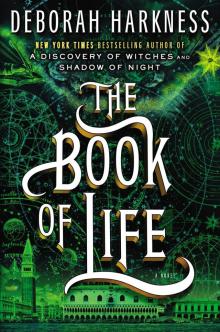 The Book of Life
The Book of Life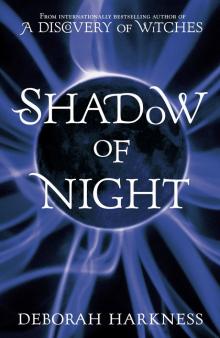 Shadow of Night
Shadow of Night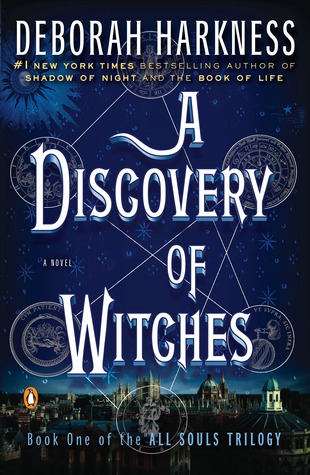 A Discovery of Witches
A Discovery of Witches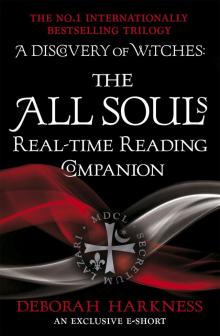 The All Souls Real-Time Reading Companion
The All Souls Real-Time Reading Companion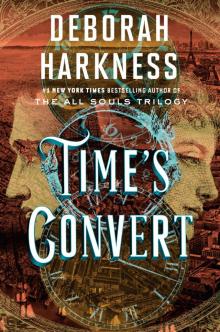 Time's Convert
Time's Convert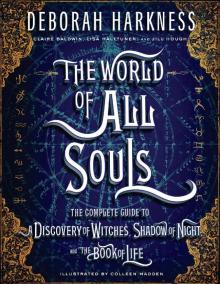 The World of All Souls
The World of All Souls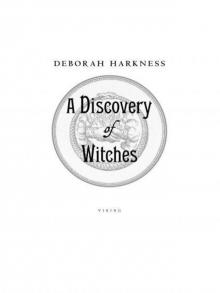 A Discovery of Witches: A Novel (All Souls Trilogy)
A Discovery of Witches: A Novel (All Souls Trilogy) Shadow of Night: A Novel
Shadow of Night: A Novel